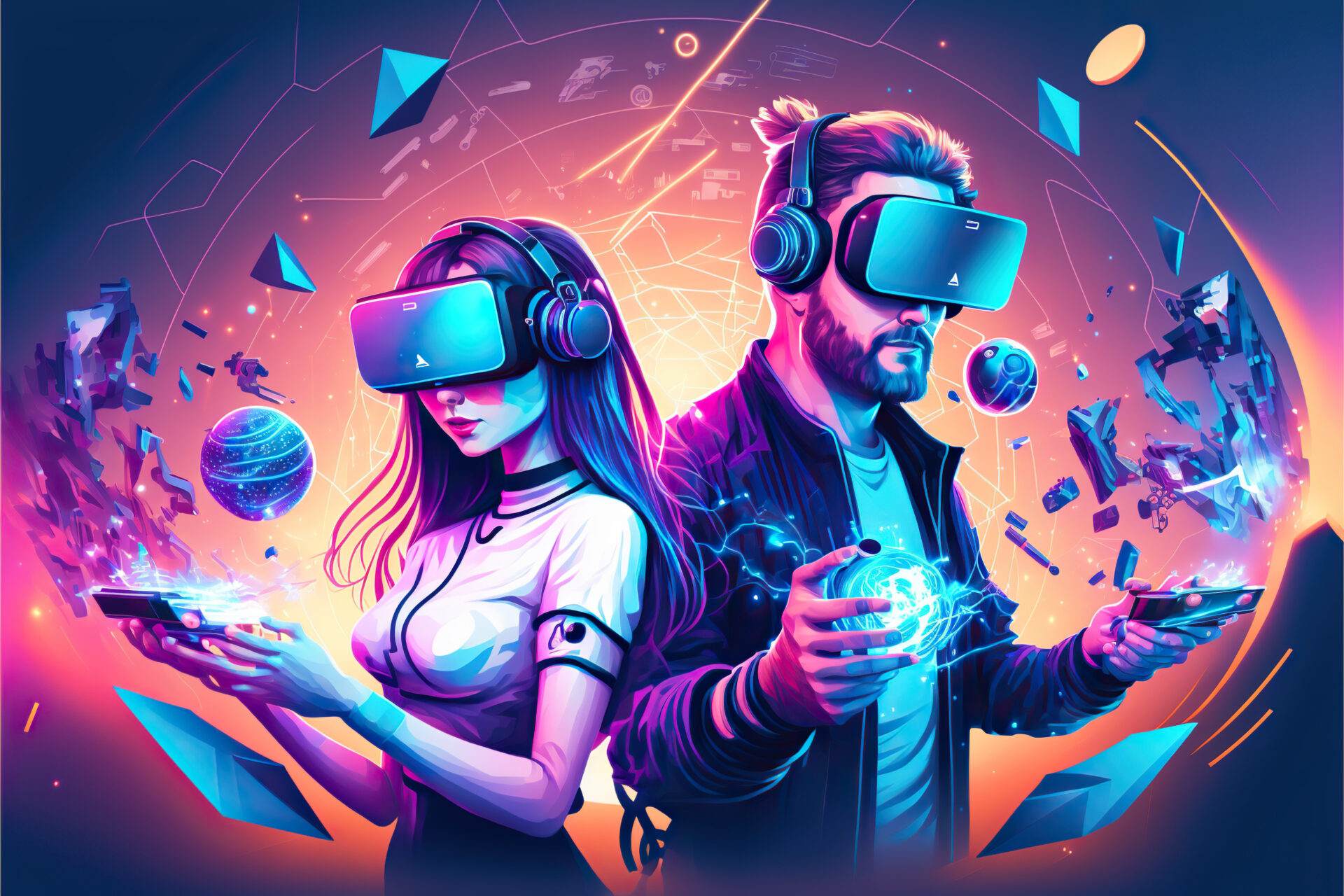Imagine strolling through a virtual mall, engaging with sales assistants, trying on clothes, and customizing products in real-time—all without stepping outside your home. This isn’t a futuristic pipe dream; it’s the Metaverse revolutionizing how we shop.
The Metaverse is no longer just a buzzword for tech enthusiasts. It is actively transforming the e-commerce landscape by creating truly immersive, interactive experiences that bridge the gap between physical and digital retail. It is the same for both businesses and consumers, the opportunities are immense. But what does this transformation really mean? And how can businesses prepare for this shift?
In this blog post, we’ll explore how the Metaverse is shaping the future of e-commerce, analyze its current innovations, and discuss real world examples and challenges.
The Metaverse: A Brief Overview
Before diving into how it is reshaping e-commerce, let’s define what the Metaverse actually is. The Metaverse is an interconnected virtual world where users can socialize, work, shop, and play using avatars. It leverages technologies like augmented reality (AR), virtual reality (VR), blockchain, and artificial intelligence (AI) to create experiences that feel as real as physical interactions.
Why Should E-commerce Businesses Care?
Consumer expectations are changing rapidly. Today’s shoppers want more than just functionality—they crave experiences. Traditional e-commerce platforms often fall short in providing the sensory and emotional engagement of physical retail. The Metaverse, however, offers a unique opportunity to fill this gap, making shopping not just convenient but also memorable.
According to a recent research, the Metaverse could become an $800 billion market in 2024, with e-commerce being a significant contributor. For businesses, this isn’t just an opportunity—it’s a necessity.
Key Innovations in Metaverse E-commerce
The Metaverse is transforming e-commerce in ways that were unimaginable just a decade ago. Here are the most impactful innovations:
-
Immersive Virtual Storefronts
Gone are the days of static product pages. In the Metaverse, brands can create virtual storefronts where customers can explore products in a fully immersive environment. These spaces replicate the experience of walking into a physical store but with added layers of customization and interactivity.
Real World Example:
Retail giant Nike launched “Nikeland” in Roblox, a virtual space where users can interact with products, play games, and even design their own sneakers. This move not only engaged younger audiences but also highlighted the potential of immersive retail.
Why It Matters:
Virtual storefronts enhance customer engagement and make online shopping a more tactile, interactive experience. According to a PwC report, 43% of consumers are willing to pay more for the products they can interact with virtually.
-
Personalized Avatars and Try On Features
One of the most innovative aspects of the Metaverse is the ability to create lifelike avatars. These avatars can try on clothes, test accessories, and even experiment with makeup or hairstyles, offering a realistic preview of products.
Better Personalization:
Avatars can be customized to replicate the shopper’s exact physical appearance, ensuring a perfect fit for apparel or accessories. This reduces the likelihood of returns, a common pain point in e-commerce.
Brand Highlight:
Luxury retailer Gucci introduced a virtual try-on feature for its sneakers. This feature allowed users to see how the products look in real-time. This feature, combined with the brand’s entry into the Metaverse through Roblox, has set a new benchmark for interactive retail.

-
Social Shopping and Community Experiences
Shopping has always been a social activity, and the Metaverse improves this by enabling users to shop with friends, attend live product launches, and even participate in virtual fashion shows.
The Social Element:
The Metaverse allows for real-time interactions with friends and other shoppers. Imagine entering a virtual store, discussing products with your friends, and making group purchasing decisions—all while being miles apart.
Case in Point:
Balenciaga hosted a digital fashion show in Fortnite, where players could dress their avatars in Balenciaga’s latest collection. This innovative approach blurred the lines between gaming, fashion, and e-commerce, creating a unique social shopping experience.
-
Blockchain and NFTs: Redefining Digital Ownership
Blockchain technology is a cornerstone of the Metaverse, ensuring secure and transparent transactions. Non-fungible tokens (NFTs), in particular, are reshaping how we think about ownership.
Applications in E-commerce:
- Digital Exclusives: Brands can offer limited-edition digital goods as NFTs, creating a sense of exclusivity.
- Traceability: Blockchain ensures that transactions are secure and products are authentic, which is especially important for luxury items.
Real World Success:
Adidas partnered with NFT creators to launch a collection of virtual sneakers. This collaboration generated significant buzz and highlighted how NFTs can drive engagement and revenue.
-
Gamification of Shopping
Gamification is one of the most engaging aspects of the Metaverse. Brands are integrating game like elements into the shopping experience to attract younger audiences and boost customer retention.
Examples of Gamification:
- Earning rewards or points by completing challenges.
- Unlocking exclusive products by reaching certain milestones.
- Participating in treasure hunts or virtual quests.
Brand Spotlight:
Tommy Hilfiger created a virtual store in Decentraland where users could interact with products, participate in games, and earn discounts. This approach turned shopping into an adventure, making it more engaging.
-
Improved Data Collection and Insights
The Metaverse enables businesses to gather data on consumer preferences and behaviors in unprecedented ways. Every interaction in a virtual environment can provide insights that help refine products, marketing strategies, and overall user experience.
Practical Benefits:
Brands can analyze how users navigate virtual stores, which products they interact with the most, and how long they spend in specific areas. This level of detail was previously unattainable in traditional e-commerce settings.
How Consumers Benefit from Metaverse E-commerce
While businesses reap the rewards of enhanced engagement and revenue, consumers also stand to gain significantly from the Metaverse:
- Convenience: Shop from anywhere while enjoying the benefits of an in-store experience.
- Personalization: Tailored recommendations and realistic try-ons make decision-making easier.
- Sustainability: Digital goods reduce waste, aligning with the growing demand for eco-friendly practices.
- Engagement: Interactive and entertaining shopping experiences make the process enjoyable rather than mundane.
Challenges in Adopting the Metaverse for E-commerce
Despite its immense potential, the Metaverse is not without challenges:
-
Accessibility
High-speed internet, VR headsets, and other technologies required for the Metaverse can be prohibitively expensive for some users.
-
Learning Curve
Both businesses and consumers need time to adapt to this new ecosystem. For businesses, this means investing in training and user education.
-
Privacy Concerns
As more data is collected in the Metaverse, protecting user privacy and preventing breaches becomes paramount.
-
Standardization
With multiple platforms emerging, a lack of standardization could lead to fragmentation and interoperability issues, complicating the consumer experience.
Preparing Your Business for the Metaverse
To thrive in this new era, businesses need to act strategically:
-
Start Small
Experiment with AR or VR features, such as virtual try-ons or 3D product visualizations. Use these projects as stepping stones to full-scale Metaverse integration.
-
Collaborate with Experts
Partner with developers specializing in Metaverse technology to ensure a smooth transition.
-
Focus on User Experience
Prioritize creating intuitive and engaging experiences. The Metaverse is all about interaction, so invest in tools that make shopping more enjoyable.
-
Build Trust
Address privacy concerns by being transparent about data usage and implementing robust security measures.
The Future of E-commerce in the Metaverse
The Metaverse is poised to redefine the future of e-commerce in profound ways. One of which is through innovations that promise to blur the lines between physical and digital shopping. Here’s what to expect:
- AI-Powered Personalization: Hyper-tailored shopping experiences that predict consumer needs and desires with astonishing accuracy. Imagine an AI-driven virtual assistant that knows your preferences better than you do, curating items you’ll love and offering them in a seamlessly interactive environment.
- Hybrid Retail Models: The integration of virtual and physical shopping environments will enable consumers to transition effortlessly between these two realms. Picture yourself browsing a virtual showroom, selecting an item, and picking it up from a physical store within hours. This synergy will cater to diverse consumer preferences, enhancing convenience and satisfaction.
- Sustainable Practices: Virtual inventories and digital products will significantly reduce the environmental footprint of traditional e-commerce. As sustainability continues to be a priority for both businesses and consumers, the Metaverse offers a solution that aligns profitability with eco-consciousness.
- Increased Accessibility: As technological advancements continue, the tools needed to access the Metaverse will become more affordable and widespread. This democratization of technology will open up new markets and enable more consumers to enjoy the benefits
The Metaverse is a Game Changer
The Metaverse isn’t just a passing trend—it’s a fundamental shift in how we interact, shop, and connect. For businesses, it represents an opportunity to create richer, more engaging experiences that resonate with modern consumers.
Whether you’re a small retailer or a global brand, embracing the Metaverse today can set you apart in an increasingly competitive market. The question isn’t whether you should join the Metaverse it’s how soon you can make the leap.




